The Content Creation Market is estimated to be valued at USD 21.0 billion in 2025 and is projected to reach USD 67.5 billion by 2035, registering a compound annual growth rate (CAGR) of 12.4% over the forecast period.
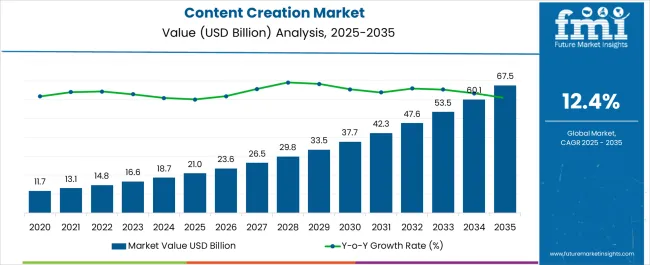
| Metric | Value |
|---|---|
| Content Creation Market Estimated Value in (2025 E) | USD 21.0 billion |
| Content Creation Market Forecast Value in (2035 F) | USD 67.5 billion |
| Forecast CAGR (2025 to 2035) | 12.4% |
The content creation market is expanding rapidly, driven by rising digital engagement, the growing importance of brand visibility, and the increasing role of AI-driven tools in creative workflows. Industry publications and company announcements have emphasized how enterprises and individuals are investing heavily in scalable solutions for producing marketing content, training material, and customer communications.
Advancements in generative AI, cloud computing, and collaborative platforms have enhanced productivity while reducing production time. Moreover, enterprises are prioritizing content personalization to improve customer experiences, which has accelerated the adoption of advanced content creation tools across industries.
Strategic investments from software vendors and integrations with analytics, distribution, and social media platforms have further strengthened the ecosystem. Looking forward, market growth is expected to be shaped by a rising demand for multilingual content, video and interactive formats, and enterprise-wide content automation. Segmental growth continues to be driven by textual formats, cloud-based tools, and large enterprise adoption due to their scalability, cost-effectiveness, and alignment with digital-first business strategies.
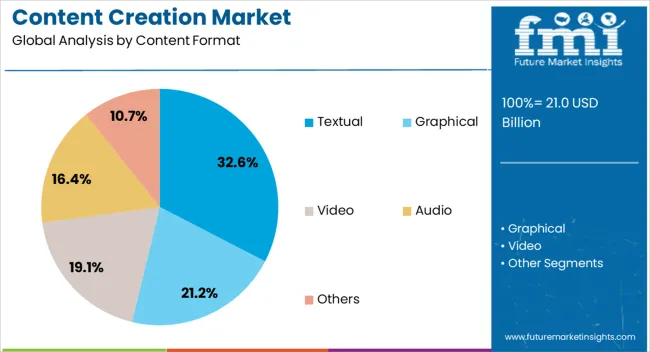
The Textual segment is projected to account for 32.6% of the content creation market revenue in 2025, maintaining its leadership among content formats. Growth of this segment has been driven by the consistent need for written material across industries, including marketing copy, technical documents, training resources, and customer support content.
Text-based assets remain essential for search engine optimization, regulatory compliance, and business communications, ensuring sustained demand. Technological advances, such as natural language generation and AI-assisted editing, have further strengthened the scalability and efficiency of textual content production.
Enterprises have increasingly invested in content governance and workflow management systems, emphasizing the central role of textual formats in brand consistency. As businesses continue to expand their global reach, demand for multilingual textual content has grown, supporting the segment’s steady market share.
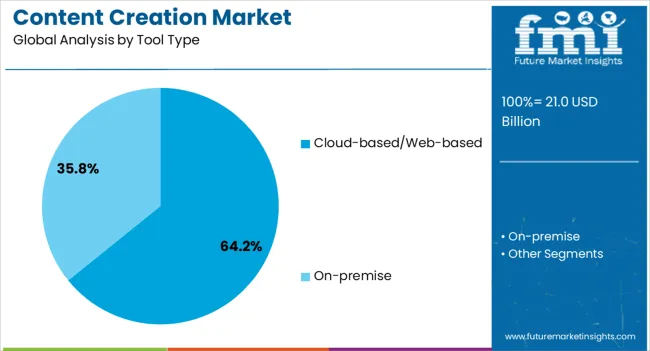
The Cloud-based/Web-based segment is projected to capture 64.2% of the content creation market revenue in 2025, solidifying its position as the leading tool type. This dominance has been supported by the shift toward subscription-based software delivery, which allows for continuous updates, scalability, and ease of integration with enterprise ecosystems.
Cloud-based platforms have enabled remote collaboration, making them indispensable in hybrid and globally distributed work environments. Industry reports and technology announcements have highlighted the growing adoption of web-based tools with embedded AI capabilities for automation, analytics, and real-time editing.
Furthermore, enterprises have benefited from lower upfront investment and predictable operating costs associated with SaaS models, accelerating migration away from on-premise solutions. With security protocols, compliance features, and cross-platform accessibility improving steadily, cloud-based tools are expected to remain the preferred option for content creators across industries.
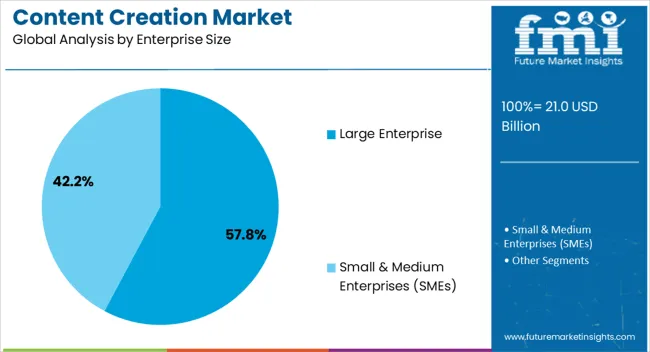
The Large Enterprise segment is projected to hold 57.8% of the content creation market revenue in 2025, sustaining its leadership across enterprise size categories. This segment’s growth has been influenced by the increasing emphasis on brand reputation, customer engagement, and global outreach strategies among large organizations.
Enterprises have adopted advanced content creation tools to streamline workflows, support multiple teams, and maintain consistent brand messaging across diverse markets. Corporate disclosures and technology investment reports have revealed significant budget allocations toward AI-powered platforms, cloud-based content hubs, and integrated marketing ecosystems.
Large enterprises have also driven the demand for secure, compliant, and scalable solutions capable of managing high content volumes and diverse formats. Their preference for vendor partnerships and enterprise-grade service level agreements has further fueled the adoption of premium solutions. With a continuing focus on digital transformation and customer experience management, the Large Enterprise segment is expected to dominate content creation adoption in the foreseeable future.
Authoring, publishing digital material, and distributing are made easier with content production software, which is driving the demand for content creation from around the globe. The widespread usage of social media platforms such as Instagram, Twitter, Facebook, and LinkedIn, among others, is opening up a wide variety of content creation market opportunities.
The lack of open-source software, on the other hand, is a major impediment to the expansion of the market size. Furthermore, the content creation market trends are predicted to advance due to rising digitization, increased use of social media marketing, and increased availability of high-speed internet connectivity.
The growing importance of client involvement and appropriate advertising through the Internet is likely to fuel the content development business. As a result, the global market for content development is augmenting. Furthermore, the expansion of the content creation market size is aided by businesses' increased marketing budgets.
On account of the constantly rising demand for social media marketing, the worldwide market is expected to move forward significantly during the projected period. Implementing content creation tools is helping businesses increase revenue and promote their brands as well as augment their contention creation market share.
In addition, the adoption of content creation is on the surge owing to the usage of content development technologies in the education sector. However, the widespread availability of free content production tools is limiting the usage of content creation tools on a big scale.
In light of numerous privacy concerns, certain governments have enacted rules governing the distribution of content. As a result, the use of content technologies is restricted in many countries, impeding the overall content creation market outlook.
The rising implementation of SaaS or cloud models is a significant factor driving market growth. Due to its cost-effectiveness, immense computing capacity, and flexibility, the technology is gaining a large customer base. Furthermore, as content creation processes evolve, so do the ways in which content creation technologies are used, and the same is likely to augur well for market future trends.
Based on the content format, the market is segmented into textual, graphical, video, audio, and others. The market, based on tool type, is categorized into cloud-based content creation tools and on-premise content creation tools. The cloud-based segment is likely to hold 72.4% of the content creation market share.
Cloud is being democratized for companies and individuals, allowing everyone to participate in the digital economy. As producers find it simple to communicate tales cooperatively, the cloud has grown capable of handling workloads in the media and entertainment business. As a result, the revenue of the cloud is likely to rise at an exponential rate in the content creation market, which is expected to develop at an exponential rate.
Based on enterprise size, the market is segmented into large enterprises and small & medium enterprises (SMEs), where the large enterprises segment is expected to dominate the market with a market share of 77.2%.
In terms of the end-use industry, the market is categorized into IT & telecom, travel & hospitality, retail, education, healthcare, media & entertainment, and others. The IT & telecom segment is anticipated to be at the forefront of the market, with a content creation market share of 38.4% through 2035.
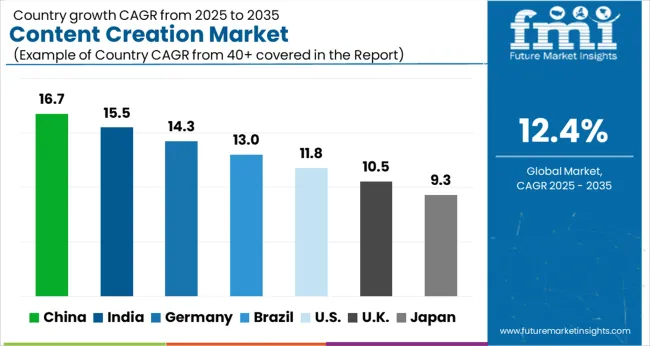 The United States is likely to account for a significant share on account of the widespread adoption of content creation tools across a variety of industry verticals and the presence of leading tool developers in the region.
The United States is likely to account for a significant share on account of the widespread adoption of content creation tools across a variety of industry verticals and the presence of leading tool developers in the region.
The content creation market in the United States is expected to increase significantly during the forecast period with a CAGR of 11.9%. Due to the increased usage of content creation tools and services across emerging countries, China and Japan markets are predicted to be the significantly expanding region throughout the projection period.
The United Kingdom is likely to have a significant presence in this market, advancing at a 10.7% growth rate.
China is expected to rise due to an increase in the number of small and medium businesses across leading nations and increased adoption of marketing methods during the forecast period. In addition, the United Kingdom is also likely to have a significant presence in this market, advancing at a 10.7% growth rate.
The United States is likely to account for a significant share. The market in the United States is anticipated to expand significantly during the forecast period with a CAGR of 11.9%, on account of the widespread adoption of content creation tools across a variety of industry verticals and the presence of leading tool developers in the region.
China and Japan markets are predicted to significantly expanding markets throughout the projection period due to the increased usage of content creation tools and services across emerging countries. During the forecast period, the market in China is expected to rise due to an increase in product approvals, product launches, and other organic growth strategies such as patents and events are being prioritized by several companies.
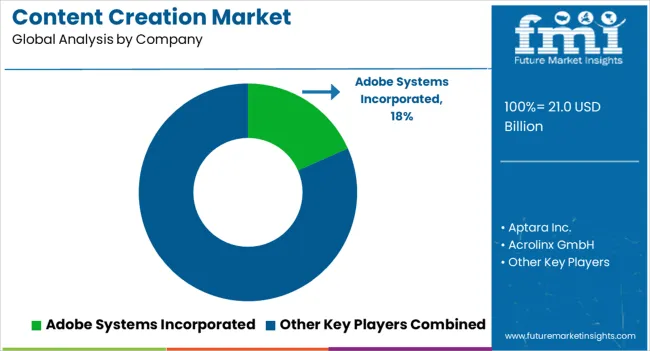
Acquisitions, as well as partnerships and collaborations, were seen as inorganic growth tactics in the market. These initiatives have paved the road for market players to expand their business and client base and are bringing about emerging trends in the content creation market. Also, with the increased demand for filter products in the worldwide industry, market players are expected to benefit from significant growth prospects in the future.
Recent developments
The global content creation market is estimated to be valued at USD 21.0 billion in 2025.
The market size for the content creation market is projected to reach USD 67.5 billion by 2035.
The content creation market is expected to grow at a 12.4% CAGR between 2025 and 2035.
The key product types in content creation market are textual, graphical, video, audio and others.
In terms of tool type, cloud-based/web-based segment to command 64.2% share in the content creation market in 2025.






Our Research Products

The "Full Research Suite" delivers actionable market intel, deep dives on markets or technologies, so clients act faster, cut risk, and unlock growth.

The Leaderboard benchmarks and ranks top vendors, classifying them as Established Leaders, Leading Challengers, or Disruptors & Challengers.

Locates where complements amplify value and substitutes erode it, forecasting net impact by horizon

We deliver granular, decision-grade intel: market sizing, 5-year forecasts, pricing, adoption, usage, revenue, and operational KPIs—plus competitor tracking, regulation, and value chains—across 60 countries broadly.

Spot the shifts before they hit your P&L. We track inflection points, adoption curves, pricing moves, and ecosystem plays to show where demand is heading, why it is changing, and what to do next across high-growth markets and disruptive tech

Real-time reads of user behavior. We track shifting priorities, perceptions of today’s and next-gen services, and provider experience, then pace how fast tech moves from trial to adoption, blending buyer, consumer, and channel inputs with social signals (#WhySwitch, #UX).

Partner with our analyst team to build a custom report designed around your business priorities. From analysing market trends to assessing competitors or crafting bespoke datasets, we tailor insights to your needs.
Supplier Intelligence
Discovery & Profiling
Capacity & Footprint
Performance & Risk
Compliance & Governance
Commercial Readiness
Who Supplies Whom
Scorecards & Shortlists
Playbooks & Docs
Category Intelligence
Definition & Scope
Demand & Use Cases
Cost Drivers
Market Structure
Supply Chain Map
Trade & Policy
Operating Norms
Deliverables
Buyer Intelligence
Account Basics
Spend & Scope
Procurement Model
Vendor Requirements
Terms & Policies
Entry Strategy
Pain Points & Triggers
Outputs
Pricing Analysis
Benchmarks
Trends
Should-Cost
Indexation
Landed Cost
Commercial Terms
Deliverables
Brand Analysis
Positioning & Value Prop
Share & Presence
Customer Evidence
Go-to-Market
Digital & Reputation
Compliance & Trust
KPIs & Gaps
Outputs
Full Research Suite comprises of:
Market outlook & trends analysis
Interviews & case studies
Strategic recommendations
Vendor profiles & capabilities analysis
5-year forecasts
8 regions and 60+ country-level data splits
Market segment data splits
12 months of continuous data updates
DELIVERED AS:
PDF EXCEL ONLINE
Content Creation Software Market Size and Share Forecast Outlook 2025 to 2035
AI-Powered Content Creation – Automating Digital Media
Social Media Content Creation Market Size and Share Forecast Outlook 2025 to 2035
Content Analytics Discovery And Cognitive Systems Market Size and Share Forecast Outlook 2025 to 2035
Content Delivery Network Industry Analysis in Korea Size and Share Forecast Outlook 2025 to 2035
Content Analytics Software Market Size and Share Forecast Outlook 2025 to 2035
Content Delivery Network Industry Analysis in Western Europe Size and Share Forecast Outlook 2025 to 2035
Content Distribution Software Market Size and Share Forecast Outlook 2025 to 2035
Content Disarm and Reconstruction Market Size and Share Forecast Outlook 2025 to 2035
Content Curation Software Market Size and Share Forecast Outlook 2025 to 2035
Content Experience Platforms Market Size and Share Forecast Outlook 2025 to 2035
Content Delivery Network (CDN) Market Report - Growth, Demand & Forecast 2025 to 2035
Japan’s content delivery network (CDN) Industry Analysis – Size, Share, and Forecast Outlook 2025 to 2035
Content Analytics, Discovery, and Cognitive Software Market Analysis by Product Type, End User, and Region through 2035
Content Service Platform Market Trends - Demand & Growth Forecast 2025 to 2035
Content Intelligence – AI-Powered Insights for Marketers
Content as a Service (CaaS) Market
Content Automation AI Tools Market
Content Protection and Watermarking Market
Content Delivery Network Security Market

Thank you!
You will receive an email from our Business Development Manager. Please be sure to check your SPAM/JUNK folder too.
Chat With
MaRIA